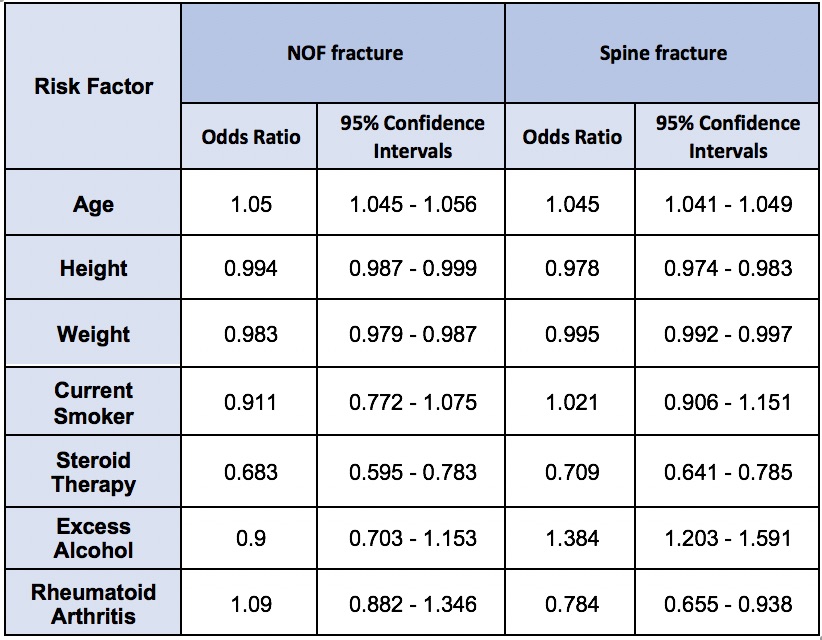Session Information
Date: Tuesday, November 14, 2023
Title: (1996–2018) Osteoporosis & Metabolic Bone Disease – Basic & Clinical Science Poster
Session Type: Poster Session C
Session Time: 9:00AM-11:00AM
Background/Purpose: Osteoporosis (OP) presents with fragility fractures, which can cause significant disability and cost to health services globally. There has been extensive research looking at risk factors for osteoporosis and fractures but less into how these factors are predicted at different bony sites. We aimed to compare risk fractures for fractures in patients with isolated L1-L4 vertebrae OP compared to isolated hip OP in a large dataset.
Methods: Data were obtained from patients referred for DEXA scan in the North-West of England between 2004 and 2011. Upon attendance, demographic details, full medical history including risk factors for fracture presence of fracture were recorded. These data was retrospectively analysed using STATA(tm) , with chi squared test used for categorical data and independent sample t-test for continuous data. We then fitted logistical models reporting odds of fracture using risk factors included in the FRAX(tm) tool (age, height, weight, family history, smoking, alcohol excess, rheumatoid arthritis and steroid use) to look for predictors of fracture.
Results: The total cohort comprise 31546 patients (82% female). 2530 patients had isolated vertebral osteoporosis and 1363 had isolated hip OP. Results are shown in table 1 below. Age was significantly associated with fractures at both sites with greater fracture risk at the hips compared to the spine. Height was protective for fractures and osteoporosis at both sites. Interestingly, whilst height was less associated with fracture in patients with hip OP, it gave greater protection against fractures at the spine. Weight was more protective for fractures at the hips compared to the spine but whilst it was protective for OP at both sites, there was no significant difference between them. Smoking increased risk of OP but with no significant difference between the two sites and had no effect on fracture risk. Use of steroids was surprisingly protective of fractures at both sites, without a significant difference between them. Excess alcohol was protective against fracture in both sites with no significant difference between them and was associated with an increased risk of fractures in the spine but not in the hip. Rheumatoid arthritis (RA) increased risk of osteoporosis in the hip but not in the spine. RA also inferred greater risk of fractures at the hips but unfortunately didn’t reach statistical significance in the spine.
Conclusion: Our study shows that established risk factors for fractures may affect different bony sites in distinct ways. The FRAX(tm) risk factors underperform in both cohorts This suggests that isolated spinal or hip OP may be a distinct disease and might need be assessed and treated differently. Our strengths include the large numbers included, but weaknesses exist in referral bas and lack of knowledge of length of exposure to risks. Further research is needed to assess how risk factors affect different bony sites, including the forearms and ribs, as well as the pathophysiology behind the differences observed.
To cite this abstract in AMA style:
Rossi N, Saeed A, Khan A, Amin H, Nadeem U, Sultan Z, Bukhari M. Predicting Fractures in Patients with Isolated Lumbar Spine Osteoporosis Compared to Those with Isolated Hip Osteoporosis [abstract]. Arthritis Rheumatol. 2023; 75 (suppl 9). https://acrabstracts.org/abstract/predicting-fractures-in-patients-with-isolated-lumbar-spine-osteoporosis-compared-to-those-with-isolated-hip-osteoporosis/. Accessed .« Back to ACR Convergence 2023
ACR Meeting Abstracts - https://acrabstracts.org/abstract/predicting-fractures-in-patients-with-isolated-lumbar-spine-osteoporosis-compared-to-those-with-isolated-hip-osteoporosis/

